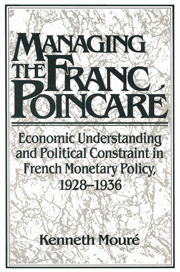 Managing the Franc Poincaré
Managing the Franc Poincaré Book contents
- Frontmatter
- Contents
- List of figures and tables
- Acknowledgments
- Abbreviations used in the notes
- Introduction
- 1 The depression in France
- 2 French gold accumulation, 1928–1932
- 3 The World Economic Conference and the gold bloc
- 4 The Bank of France: market control and interest-rate policy
- 5 The Treasury and government finance
- 6 The devaluation debate
- 7 Devaluation of the franc
- Conclusion
- Appendix
- Bibliography
- Index
5 - The Treasury and government finance
Published online by Cambridge University Press: 23 November 2009
- Frontmatter
- Contents
- List of figures and tables
- Acknowledgments
- Abbreviations used in the notes
- Introduction
- 1 The depression in France
- 2 French gold accumulation, 1928–1932
- 3 The World Economic Conference and the gold bloc
- 4 The Bank of France: market control and interest-rate policy
- 5 The Treasury and government finance
- 6 The devaluation debate
- 7 Devaluation of the franc
- Conclusion
- Appendix
- Bibliography
- Index
Summary
In 1928, with the franc securely back on gold, gold reserves rising, and the budget nearly 4 billion francs in surplus, the Treasury was “in the most prosperous position it has ever known”. In such circumstances, there was little reason for conflict between the Treasury and the Bank of France. Their responsibilities conflicted when government financial needs disrupted money markets or made excessive demands on the Bank as the state's lender of last resort (through either direct advances to the state or by discounting Treasury bills for the commercial banks). With the budget in surplus, they coexisted happily. In 1930–1 the budget slipped back into deficit. This was not immediately threatening after several years of surplus, but it became so as the deficit persisted. The financial crises of the 1920s had taught that budget deficits were the root of all financial evil. Deficits resulted from financial mismanagement, from governments living beyond their means, and the 1926 Poincaré recovery had shown that resolute leadership would restore budget equilibrium. A budget deficit, by increasing Treasury borrowing, would open the way for central bank advances to the state, inflation, currency depreciation, and economic collapse. In 1926 Raymond Poincaré had rescued France from the brink of financial disaster by restoring a strictly balanced budget.
In his annual report delivered in January 1933, Clément Moret warned the government of the urgency of fiscal reform: The Bank of France would tolerate neither half-measures in balancing the budget, nor a resumption of advances to the state.
- Type
- Chapter
- Information
- Managing the Franc PoincaréEconomic Understanding and Political Constraint in French Monetary Policy, 1928–1936, pp. 156 - 190Publisher: Cambridge University PressPrint publication year: 1991


